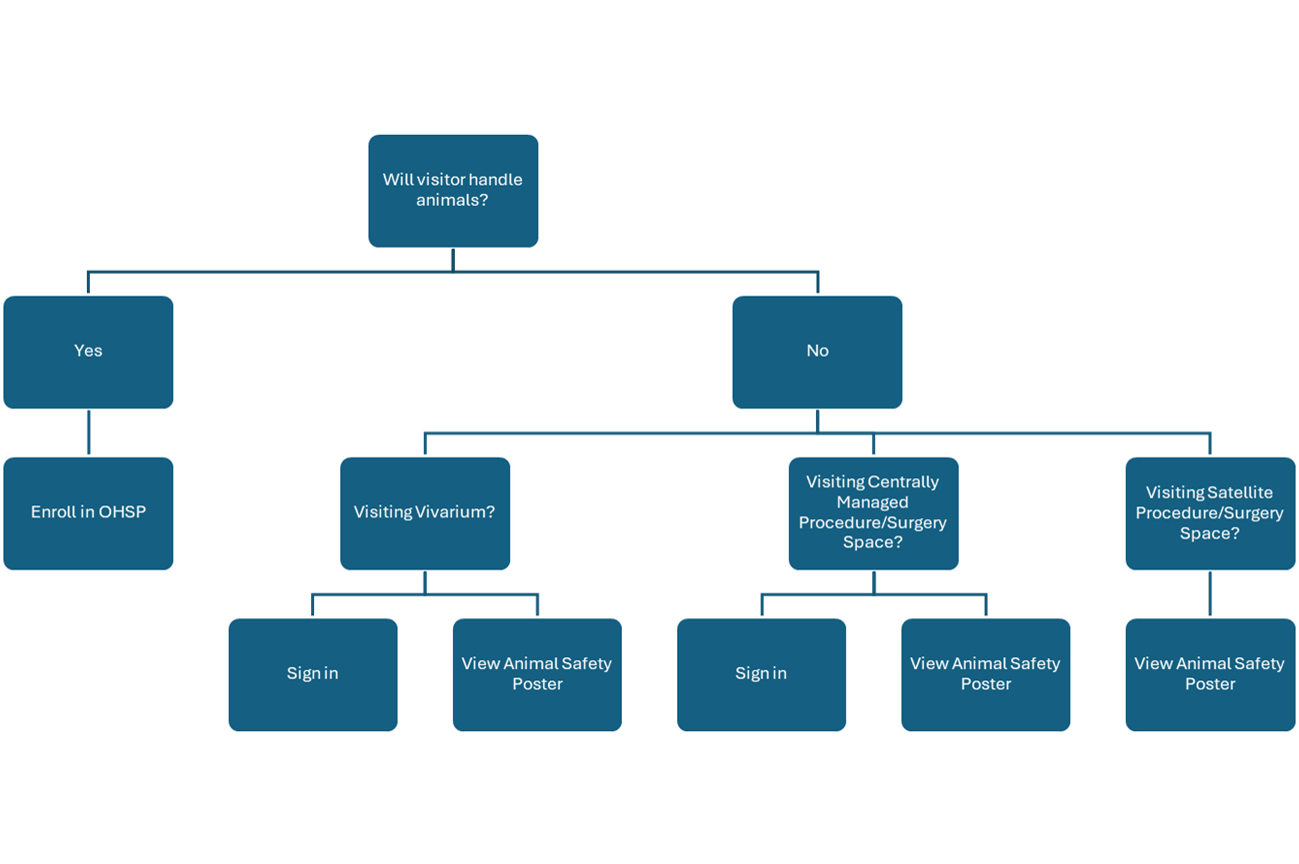Purpose
The University of Oregon (UO) recognizes there are various circumstances where both University and non-University personnel require access to UO animal housing and use spaces. The purpose of this policy is to safeguard animals, personnel, and property when visitors enter a facility, including any satellite facility, overseen by the Institutional Animal Care and Use Committee (IACUC). This policy also provides a method for informing users regarding their potential risks and hazards when entering animal housing and use spaces without fully enrolling them in the Occupational Health and Safety Program.
Scope
This IACUC policy applies to all visitors entering the UO animal housing and use spaces and IACUC-approved satellite holding rooms who are not enrolled in the Occupational Health and Safety Program, who are not covered under the IACUC Policy on Visiting Scientists, and who will not have direct contact with animals.
Background/definitions
Animal facility
Any areas housing animals that are:
- UO-managed vivarium
- Centrally managed surgery suites
- Centrally managed procedure spaces
- Satellite vivarium
- An addendum will be made available and attached to this IACUC policy that lists all locations currently covered.\
Visitor
Anyone who does not work directly with animals and has been granted access to a UO animal facility is considered a “visitor”. This includes anyone who is not listed on an active IACUC protocol for that facility or without specific permission to enter animal facilities as part of their job. Examples of people who have permission as part of their job include UO Animal Care staff, approved UO safety and facilities management personnel, UO-contracted service technicians, etc. Visiting Scientists, or those whom require animal handling as part of their job/volunteer services, are required to adhere to the ‘Visiting Scientist Guidelines.’
Chaperone
A UO employee who has completed all required EHS- and IACUC-approved training and is authorized to access the animal facility. This chaperone may be a member of the UO staff, a Principal Investigator (PI), a laboratory technician, a researcher, or an IACUC member.
Sign In Sheet
Internally managed document maintained by each group and available for review by the IACUC upon request. These may be hard copy or digital.
Policy
UO is committed to ensuring that all aspects of a sound program of animal care extend to visitors to the animal facilities.
Access Request and Processing
- Visitors or their chaperone must gain permission from the Facility Director, Manager, or Attending Veterinarian as well as the Principal Investigator (if applicable) prior to entry to the animal facility. They should provide the following information:
- Visitor name
- Email address
- Chaperone
- Date(s) of visit
- Facility Directors/Managers and or Chaperones should address concerns or questions about pending visitation requests with the IACUC Chair, Environmental Health & Safety (EHS) Director, or Campus Police.
- Facility Directors/Managers have the authority to deny visitation requests.
- Prior to their visit, visitors must review the Animal Safety Poster describing the risks and hazards they may be exposed to during their visit.
Rules and Guidelines
- Visitors must review the Animal Laboratory Safety poster prior to entry.
- Individuals must always be accompanied by the chaperone while visiting the animal facility, unless otherwise approved by the Facility Director/Manager.
- Users with known animal allergies must only visit housing locations where terrestrial or avian animals are held in filtered caging racks.
- Users must comply with all UO, IACUC, EHS, and safety rules and regulations. This includes respecting animal environment and welfare conditions, for example, no shouting or unruly behavior, knocking or tapping on animal enclosures, or running in the facility.
- No minors under 18 years of age are permitted to enter the facilities without parent or guardian approval or accompaniment. It is the responsibility of the chaperon to obtain guardian approval prior to entry.
- Visitors are not permitted to photograph, video, or audiotape research animals or the facility unless previous approval has been obtained from the chaperone and in accordance with the Animal Care Facility Photo, Video, and Social Media Guidelines.
- The consumption of food, drink, or use of tobacco products is prohibited within the animal facilities.
- Users must wear appropriate Personal Protective Equipment (PPE) as supplied. This also includes wearing closed-toed shoes and tying back long hair.
- All injuries must be immediately reported to the Facility Director/Manager, who reports incidents to EHS.
- Failure to follow these guidelines will result in the visitor being immediately escorted out of the UO animal facility and may result in the visitor being removed from UO property.
Exceptions
- External inspectors with regulatory need to visit or inspect animal care activities, such as the United States Department of Agriculture (USDA), Office of Laboratory Animal Welfare (OLAW), AAALAC International, IACUC members, and certain research sponsors are permitted access and may capture photographs, video, or audio recordings in accordance with the Animal Care Facility Photo, Video, and Social Media Guidelines.
- The Charleston Marine Life Center (CMLC) and Oregon Institute of Marine Biology (OIMB) are exempt from this policy due to the public nature of their facilities (visitation center) and internal tracking mechanisms.
- Procedure spaces outside of the animal facility: Chaperones must have visitors review the Animal Laboratory Safety sheet prior to entry into procedure spaces. Whether visitors are required to sign in is at the discretion of the chaperone/laboratory.
- Group visits/tours: Groups of >5 individuals are not required to sign in individually. Visitors must view the Animal Laboratory Safety poster prior to their visit. Chaperones may sign in for these groups but must have a list of individuals available upon request if needed for follow-up.

Approvals
Effective date: 04/01/2025
Issued By
Stephanie Womack, Director of Animal Welfare Services
